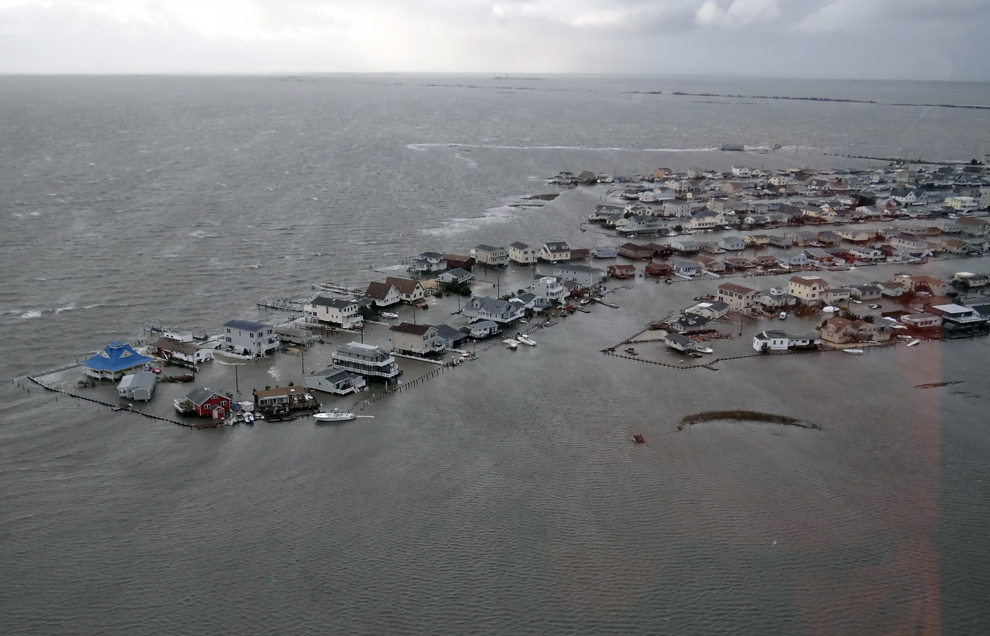It’s not surprising that Corps of Engineers beach replenishment projects get big bucks from Congress and lots of media attention. After all, that’s where everyone goes for the boardwalks, Ferris wheels and ludicrously expensive summer rentals.
Beach replenishment advocates say those billions of dollars generated by beach resorts make the Corps projects a relative bargain. As an example, they point to New Jersey’s Long Beach Island, where hurricane Sandy failed to punch through the barrier beach in places where a $128 million Corps project was completed.
Of course, that did not stop the 2012 storm surge from flooding the bay behind the island, damaging thousands of homes. Coastal scientists say sea level rise along the Mid-Atlantic coast will do the same kind of end run, no matter how much sand gets pumped onto the beach.
Now those bayside communities want the same attention for their flood threats. It could be a winning combination: mitigating community risks, using dredged material to rebuild salt marshes and wildlife habitat, with lots of opportunity for the Corps and contractors.
“All the towns are dealing with sea level rise. We’re losing a lot of the habitat for wildlife,” said John Spodofora, the mayor of Stafford Township, N.J., at a June 20 meeting with officials from surrounding communities to come up with a strategy. “We’re dealing with wave action, we’re dealing with habitat loss and lagoons that are in need of dredging.”
The Sandy surge sent a sheet of water 5’ deep across the marshes and into Stafford’s Beach Haven West neighborhoods. The township lost $200 million in property tax value from the storm. But streets behind a berm built with dredged sediment escaped the worst damage, said Spodofora.
Developers dug hundreds of miles of residential lagoons like Beach Haven West in New Jersey and Florida before a 1970 law shut that down. A half-century later, the canals are loaded with silt, frustrating boat owners and lowering property values. Nearby, now-protected marshes are threatened with drowning from sea level rise. See a potential solution here?
If only it were easy. Finding money to do the work is trouble enough. A few miles south where Sandy clobbered Tuckerton, N.J., a modest project to dredge 151,350 cubic yards from creeks and lagoons and spread it on 50 acres of marsh would be financed by a $2.1 million National Fish and Wildlife Foundation grant. But changes to the plan and environmental testing will double that price by another $2 million.
Then you need the right kind of material. For beach replenishment, Corps contractors dredge clean sand from just offshore. Lagoons and bay channels are a mixed bag, with lots of muck, silty material that engineers call fines, and sometimes noxious quality.
“Sand is easy, fines are difficult to manage,” said Ginger Kopkash, an assistant commissioner with the New Jersey Department of Environmental Protection. Ever in search of beneficial uses for dredged material, government agencies have experimented with applying thin layers of sediment to gradually elevate marshes, but it is a tricky art that also requires ensuring the right kind of native plant species thrive.
There have been some successes, like work the Corps’ New York district has done to rebuild islands in Jamaica Bay. Overall the agency’s North Atlantic division is working to develop an overall management strategy to maximize efficient use of dredged material.
Advocates for that approach say that with sea level rise, what comes out of the dredges will soon be too valuable to just get rid of.
“All the estimates say it will continue to rise, and may accelerate. We have to be thinking out five, 10, 30 years beyond our lifetimes,” said Ken Able, director of the Rutgers University Marine Field Station.
“We see that material as a precious commodity that needs to stay on the system,” said Kopkash. “We can’t afford the loss.”




